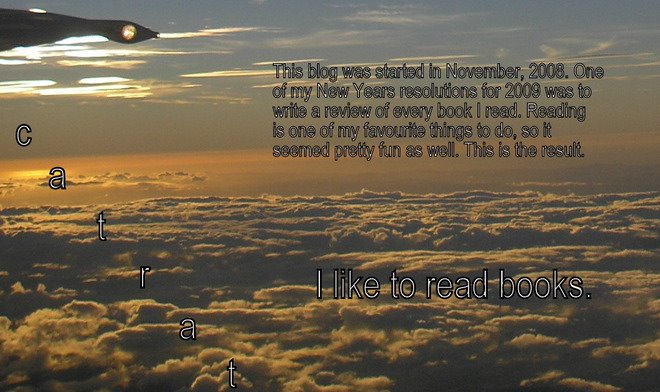skip to main |
skip to sidebar
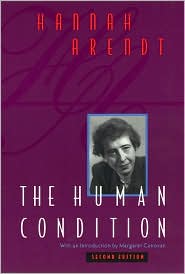
I first heard of Hannah Arendt through a lecturer who recommended her book Eichmann in Jerusalem: A Report on the Banality of Evil about the trial and subsequent execution of Adolph Eichmann in the 1960s. In this book she introduced the idea that "desk murderers" are simply a system of increasing bureaucracy, that the idea of evil is no more than a substitution of morals.
The Human Condition written before the other book was an exploration into the ramifications of what it is to be human. The book was separated into sections based on The Public and Private Realm, Labour, Work, Action and the Vita Activa (or life of action) which she believed had replaced the homo faber as the mode of the "human condition".
The historical writings on each of these concepts is explored by looking far back to biblical times then onto Plato, Aristotle, Marx, Weber and Nietzsche's interpretations of the conclusions she comes to about each of these concepts. She disagrees for example with Marx's notion that labour is the fundamental of being human, and replaces this with an new idea, drawing on other philosophies to back it up. As well as exploring philosophies she also looks into the ever-expanding realm of technology, especially the birth of astro-physics, in the prologue, she mentions the 1957 Russian launching of the first man-made satellite into orbit (Sputnik I), and how she sees these developments as important in the exploration of the human condition. It was these parts of the book I enjoyed the most, in the last section about the birth of vita activa she explored the scientific world in a way I have never seen copied that was both beautiful and philosophical.
I am unsure what the original of this book looked like, the copy I have was published in 1998, forty years after the original publication. One of the things I found annoying about this version at least was the sheer amount of footnotes used, a lot of the time things were explained in detail in footnotes that would have been better suited to the text itself. As well of this, a lot of footnotes used French and German examples without translations, which irritated me a bit as I speak little French and no German. My recommendation for future editions would be a list of endnotes - as in just references at the back of the book and symbols (asterisks and crosses) being used for the footnotes which go into more detail.
This is also not an easy book to read (it took me a week) but I don't fault it for this. It's very much an academic text, so quite a lot of the time I had to reread sentences to establish a better understanding. Despite this, it is full of in-depth knowledge and well worth a read for anyone interested in philosophy, Marxism or the works of any of the philosophers mentioned above.

This author is genius, the one thing you can be sure of in his books is that they will never ever be predictable. The twists and turns of the book come out of nowhere and seem completely unlikely but they contribute something to the plot as well. The underlying theme of religion was what kept this book going, and it did so very well.
The book details the lives firstly of Amanda and John Paul Ziller, a young couple living in the sixties in the USA. Several other characters are introduced throughout but mainly Marx Marvelous, a scientist gone astray and Plucky Purcell, an ex-athlete joining in on the spectacular.
There's not much to say about this book that won't give it away. It deals primarily with the concepts of spirituality and philosophy and each character contributes in his/her own way. There is a convergence of ideas showing the similarities between religion and science collecting an interesting philosophy throughout the entire book that not so much combines the two as it debates and settles with neither one nor the other. And when I say debates, it is not debating...
Definitely more scandalous than The Da Vinci Code but less read. Mainly because a lot of people just can't see where the hell Tom Robbins is coming from but personally I can and I think his writing borders on excellent.

As the title would suggest, this book is indeed about sex. Not only sex, but how sex continues to inspire and support the patriarchal society. I've read my share of feminist books but this one certainly has to be the most "aim-to-shock" of the lot. It does not play around, it does not stifle in the least. Like many radical feminist works, it seeks to inspire hatred towards the way we (women) are treated by men. This was the book that famously put across that all men are rapists, while I don't agree with this sentiment, what she had to say about the subject was certainly interesting.
The first part of the book explores some works of fiction and uses them to illustrate how being female creates a state of inferiority within the works and in the context of wider human society. The latter part of the book takes this argument and shoves it in your face over and over again so that reading through the last chapter I was continually wincing at the mentions of sad-masochism, child abuse, rape and more. She does have a way with language and she puts her point across incredibly strongly but I definitely wouldn't recommend reading this as quickly as I did. You've got to love radical feminists though, they certainly try to drill this stuff into you.
What the book didn't explore that other books like Cunt by Inga Muscio did is that sex can be enjoyed and is by many people, that it is not always in a patriarchal context and can be healthy and invigorating for many women. I continue to think so that this woman does have the gift of the gab, her sentences are long and draw you through to the very end, there is no sentence in the book that is put across lightly although there are moments of humour.
I'd recommend it to you, as long as you're not one of those people who finds yourself seething at the mere mention of feminism. Though this women and other feminists do take it to the extreme, it's a pretty interesting read.
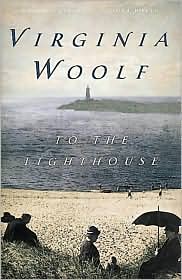
Ever since I read Mrs Dalloway in high school I have loved Woolf's writing. She has an amazing literary stream-of-conciousness style that no other author could imitate and if they tried it wouldn't work.
This book covers the vacation of the Ramsey family to the Isle of Skye, the mother figure Mrs Ramsey according to the introduction was a characterisation of Woolf's own mother, she believes in Victorian ideals, that is, valuing her family and being a good mother to her children, and a good wife to her husband above all else. Lily Briscoe, a younger girl staying in the same beach-house as the Ramseys attracts both Mrs Ramsey's disapproval and sympathy for being single and wholly more interested in her art than anything else (such as family, children or marriage). The fact that Mrs Ramsey is known only as Mrs Ramsey all through the novel helps to put across her family-oriented, idealistic life in comparison to Lily's more artistically and intellectually focused state of being.
Even after Mrs Ramsey's demise, Lily and the Ramseys' children both continue to be influenced by her strict way of thinking and strong opinions towards the life Lily has chosen or had bestowed upon her.
Lily as a character attempts to freeze states of being in her artwork, although she is continually told especially by males that women cannot paint she continues her pursuit of recording time frozen within her artwork. The ending of the remaining children going to the Lighthouse with their father, and Lily painting the scene emphasising each role within the story.
I actually liked this more than Mrs Dalloway although only marginally, if you haven't read any Woolf I strongly suggest you do so!
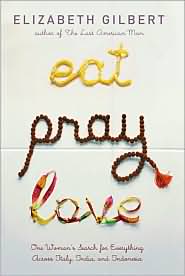
I am still in mixed minds about this book; people seem to either love it or hate it but I am somewhere in the middle. It follows a journey undertaken by the author after going through a difficult divorce and a difficult break-up. The book is separated into three sections: Eat details her time in Italy, Pray goes through her time at an ashram in India and Love covers her final leg of this journey to find herself in Bali.
I think the first leg of the journey in Italy was my favourite, it got a little too wishy washy for me after that. The book has been criticised for being too self-absorbed or narcissistic but I didn't really find it like that. The explanations at the beginning seemed to be just showing her reasons for taking this random trip around the world. I definitely don't think that she was asking for any pity or saying it was anything worse than what other people go through as has been suggested.
First of all the writing in this book was impressive, she took you on her journey every step of the way, with humour, sadness and all those other emotions. However, some of the claims to recall exact conversations with people kind of had me doubting the truth of the book. Unless the woman was carrying a dictaphone around with her in all her journeys and sexual experiences!? The conversations in the book were so detailed, they sort of reminded me of the conversational excerpts from A Million Little Pieces which were later found to be figments of the author's imagination. The other thing that annoyed me about this book is well it sort of irked my inner feminist and my inner atheist. It seemed like in this book, she divorced, rebounded, broke up with the rebound then immediately felt her life to be pretty empty and turned to God. I guess that may have been why I liked the first leg more than the others. She was independent, she relied on herself, she enjoyed food. It just seemed to me for a lot of the rest of the book there either had to be a higher power or a significant other. I rest in the truth that there doesn't have to be either and that dealing with being alone is a thing everyone has to face and overcome which she didn't seem to do.
At the same time, there were some impressive excerpts in this book which I wanted to shout to the world, paticularly in the first leg. Leaving a long-term relationship is really hard, and she did it with strength and tried to leave it behind. Again, however, the jump into a rebound relationship irked me a little. I guess what I did like is that she knew the relationship was not working and she got out of it instead of just remaining and being sad. The author has also been criticised for getting a large advance on this book before leaving on her trip. To be honest I don't blame her in the least, if I had the writing talent she has I would not hesitate to find something to fund my journey of self discovery. Seems like a good plan to me! She came through, published a book which has influenced a lot of people and that a lot of people have enjoyed so it was not like the money was undeserved.
Suffice to say, I think it's an intriguing read. It falls somewhere in the realm of a travel book, self help book or memoir. There are passages of the book I definitely think are impressive things that everyone needs to read.
Up next: To the Lighthouse by Virginia Woolf
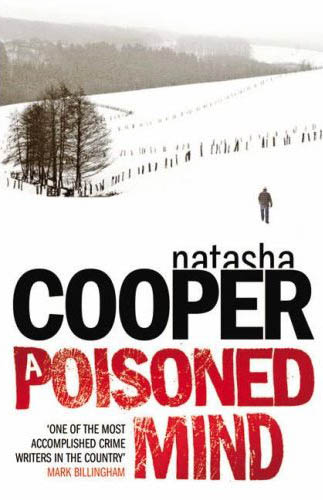
I actually liked this book more than the last one I read below Gagged & Bound, the plot line somehow seemed to ring more true to me. Perhaps the one I read first wasn't a good one to start off with as I was under the illusion that these books were about both Trish Maguire, the lawyer and her friend Caro, the police office. This one focused on just Trish with only a couple of mentions of Caro and they did not seem to be as close as they were in the other book.
This one covers a case which Trish defends on behalf of a waste management company who are being sued by a woman who's husband died after one of their tanks exploded. Trish sees something fishy in the case from the start, and begins to think the tanks on the property were somehow sabotaged. She also has personal problems with her son who's new friend's misbehavior causes problems among the family, despite this Trish and her husband take the friend under their wing who is suffering physical abuse from his brother.
The reason this book seemed more believable was the role of the lawyer and her ethical stance leading her to uncover what was an unfair case against the company she is representing. I'm doing law and just from my viewpoint it seemed she took a far more lawyer-ish stance than in the last book I read by Cooper. She has also just received her 'silks' making her a QC and this book also covers her fight to be recognised in her firm after her senior is injured in an accident.
The criticism I would have of this book is it seems to involve crisis after crisis especially with the troubled friend of her son. It did seem realistic I guess but a bit too dramatic.
A good read either way if you are into crime novels, or thrillers I recommend it.
Next up: Eat Pray Love by Elizabeth Gilbert

I need to go to the library which I will do tomorrow, so have been reading my mother's murder mysteries. I was pleasantly surprised by this author. The two principal characters are a lawyer and a police officer which will always make for an interesting story. Their stories collide as they both tackle potentially extremely dangerous cases which threaten their lives as well as that of their families.
The writing itself in this book is not anything to rant and rave about, but it follows on well and makes sense. I found myself not wanting to put the book down in the way that only a good thriller can make you feel.
Some of the time I found myself exclaiming at the stupidity of one of the characters is particular who kept pursuing a dangerous road even when she knew her family were being put in danger from what she assumed were her actions. I can't quite believe anyone with intelligence would do the things she did after she had been warned of what she was dealing with.
This book does display many situations rather well though. In particular it shows the discrepancies between those who have grown up in the British upper class compared with the working class and how many people feel like once their status has risen they have something to prove, over and above people who have previously been their superiors.
This is a good read, good enough that the next book I read was by the same author. I definitely recommend it to fans of thrillers or crime novels.

This is a non-fiction book, released in 1990 which explores the connections between bipolar illness and levels of artistic mood. It covers several studies including many by the author herself detailing lives, family trees and tentative diagnoses. It also explores whether the suffering these people went through and still continue to go through are necessary to their artistic temperaments.
The first study undertaken by the author concerns British and Scottish poets born between 1705 and 1805, each poet is diagnosed as having either recurrent depression, manic-depressive illness (Bipolar I or II) or psychotic features. In the tables provided suicide and admission to asylums is also taken into account. The comments provided also detail why a poet has been put in a particular group. Although the diagnoses cannot be taken as truth, since they are historical, they are taken from various diaries, accounts of the poets' lives and medical records. By looking at this sample and comparing it with the control group of the general population, Jamison concludes that: twenty times the general population at least were committed to asylums; thirty times more were were tentatively diagnosed with manic depressive illness, cyclothymia or depressive moods and five times the rate were more likely to kill themselves. The results are described in detail in this chapter, and while she maintains that not all the diagnoses can be taken at face value, it is easy to see that this provides a possibly extravagant but reasonable scientific demonstration.
What follows on are studies by other people and also measurements of the occurrences of mental instability by month. It also displays the productivity of the artists by months; while some produce more effectively in times where their illness is the worst, many produce more when they are more well. It also compares the illnesses among different types of artists: poets, painters, authors, etc.
A case study into the famous poet Lord Byron (George Gordon) is then outlined. His works as well as medical records and family history are used to display illness in his life and those around him, and it illustrates how his illness was displayed throughout his poetry. The same is then done with Alfred, Lord Tennyson; Robert Schumann; the James family; Herman Melville; Samuel Taylor Coleridge; Virginia Woolf; Ernest Hemingway; Mary Wollstonecraft and Mary Shelley; Samuel Johnson and James Boswell and Vincent Van Gogh.
This book is not meant to be easy to read, and does not necessarily aim to display that all art is undertaken within mania or great depression. It is not always easy to follow but if you have an interest in the subject it provides an interesting insight.
A parting poem by Lord Byron:
She Walks in Beauty
SHE walks in beauty, like the night
Of cloudless climes and starry skies;
And all that 's best of dark and bright
Meet in her aspect and her eyes:
Thus mellow'd to that tender light
Which heaven to gaudy day denies.
One shade the more, one ray the less,
Had half impair'd the nameless grace
Which waves in every raven tress,
Or softly lightens o'er her face;
Where thoughts serenely sweet express
How pure, how dear their dwelling-place.
And on that cheek, and o'er that brow,
So soft, so calm, yet eloquent,
The smiles that win, the tints that glow,
But tell of days in goodness spent,
A mind at peace with all below,
A heart whose love is innocent!

This book didn't differ hugely from her other books, it was full of twists and turns which keep the reader turning the pages, although I will say I thought the ending was slightly unnecessary. She also related the career of the mother, Charlotte as a chef to the twists of the book with recipes and definitions of cooking terms which were good to begin with but perhaps shouldn't have been continued throughout the entire book as they veered from the plot a little and detracted from the story.
Her books do seem to follow a pattern and they can because of this be quite predictable, they do address very important issues and this one covered: adoption, abortion, eating disorders, depression and self injury, ethics, disabilities and friendships. They also provide detailed descriptions about parenting and being the mother or father of children how it can save you but also break you heart.
I'd definitely recommend this book to anyone who has read Picoult before, if you haven't I'd recommend the book also by her The Pact which I personally think is her best and provides all of the components of all her books but with some sort of ex factor.

